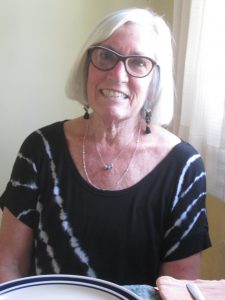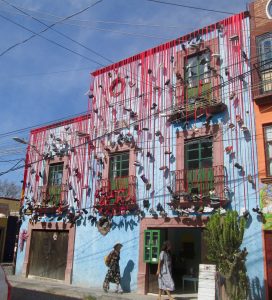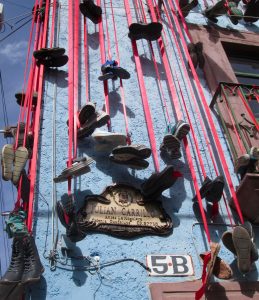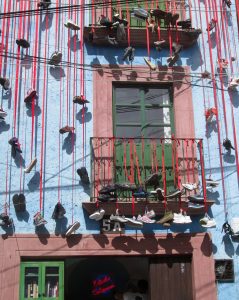When my friend Suzanne — with whom I went to high school in New Jersey in the early ‘60s, but who now lives in San Miguel de Allende, Mexico, like me — came to lunch last Tuesday, she told me about a marvelous group of remarkable women here known as Ser Mujer (“to be a woman”), and a special project they were planning for this year’s International Women’s Day on March 8th.

This project, titled “En Los Zapatos de Ella” (“in her shoes”), is one of many important programs slated for this year’s International Women’s Month in San Miguel (see Events at www.sermujersma.com ).
“En Los Zapatos de Ella,” Suzanne told me, would be an outdoor art installation of hundreds of pairs of women’s worn (donated) shoes hanging by red satin ribbon from the façade of a large home in the Colonia Guadalupe district of San Miguel – each pair of shoes representing one of the 303 homicides targeting women in Mexico’s State of Guanajuato alone in 2019.

As I learned from Suzanne, Ser Mujer is a group of about eighteen Mexican, North and South American, and Canadian women of all ages, working in partnership with community-based organizations in SMA, who are all committed to social justice, equal opportunity, and the elimination of violence against women.
Over lunch here Suzanne explained to me her involvement in the March 8th “In Her Shoes” event:
When she joined Ser Mujer last December, Suzanne was asked to bring her years of U.S. corporate management skills to bear in helping to manage and direct this art installation.
“So I wrote up a concept statement,” she told me, “and I put together a loose project plan – everything that needed to be accomplished, and so on, the way I would organize a project if I were in corporate America.”
What Suzanne hadn’t bargained on, though, was that as she presented her plan several lively conversations broke out among the women, all relevant to the subject, and all moving the ball rapidly along. When the question of where the installation should be held came up, for example, one Mexican woman took out her cell phone, right there at the meeting, called her friend the artist Tomas Joaquin Burkey Marambio, and got him to commit to use his house in Colonia Guadalupe. Done.
“This is what I perceive as the Mexican attitude of CAN DO,” Suzanne said. “There’s nothing too daunting. I’ve seen it time after time here in San Miguel. And I feel it every time I meet with these women. I always come out of Ser Mujer meetings feeling touched by their energy, their accomplishments, and their ability to make things happen. I’ve not experienced this in the same way in any other group that I’ve worked with in the United States.”
Suzanne and I agreed that we’d never celebrated – nor even known about – International Women’s Day when we lived in the States. Although it had been celebrated in other countries for years, it wasn’t until 1975 that the United Nations began acknowledging International Women’s Day, and in 1977 the U.N. General Assembly proclaimed it be held on March 8th each year. But in the U.S., where domestic violence is also rife and women are still largely treated as subordinates, the day has been generally ignored.
My first experience of International Women’s Day’s global importance was in francophone and predominantly Muslim Mali, West Africa, where La Journée Internationale de la Femme (International Women’s Day) was widely celebrated. As I wrote in my memoir How to Make an African Quilt: On March 8, 2000, I brought my Club Crochet girls – about thirty Malian girls between the ages of eight and twelve, who met at my my home each week to learn how to crochet using “yarn” made from plastic bags – to a women-only gathering at the women’s group where I taught quilting, for a day-long manifestation (event). There was laughing, dancing, singing – and eating, of course – and general celebration of our shared female-hood.
On our way to that event, I’d taught the girls a made-up marching song in French: “Nous sommes les femmes et nous sommes fortes!” (“We are women and we are strong!”), stopping to stomp our collective feet on the dusty street at every “fortes.” I felt I was leading a mini-revolution.
I must confess, Suzanne and I were not close friends in high school. In fact, I hardly knew her then. World War Three was being waged in my home at that time, so I had no energy left for socializing or after-school activities when I was a teen. I had other important obligations, such as shielding my mother from my father’s drunken blows. As soon as I was old enough, tall enough, and strong enough, I, as the eldest child still at home, made a point of silently standing in front of her when he came at her swinging. I knew he wouldn’t strike me; I wasn’t the object of his rage. So, like an enormous, deflated, wild beast, he would stop roaring and slink away.
This is what it is to be a woman in the world today: We must be strong, stand up for ourselves, and communicate coolly and clearly to all men everywhere:
No more violence against us.
No more disrespect toward us.
No more misplaced rage.
This is not a competition; men and women are meant to complement each other, in equal measure.
Come, walk for a day in our shoes.

~ ~ ~
(Please visit Ser Mujer’s website to learn more about their impressive members and their upcoming events here in San Miguel in this International Women’s Month. Also, be sure to read the informative essay, “What is Femicide?” by Paula James. Go to: www.sermujersma.com .)


After a month under the Guanajuatense sun, used shoes aren’t going to be of much use to migrant women. And it really kind of mean-spirited when you really think about it. Give these women a decent pair of slightly worn or brand new shoes.
I’m guessing that the migrant women will be the best judges of whether or not these used shoes will be of any use to them. And I’m sure if you’d like to buy them new shoes they would be extremely grateful to you.
Many shoes are new. It will be up for two weeks, not a month. I encourage you to donate something to ABBA house shelter in Celaya. These shoes are symbolic of the women that have been murdered.
Amen Bonnie. Don’t naysayers really grate?
Look, it’s a very well-done, striking installment. I like it. I understand its symbolism. Very, very food. All I know is what I’ve read in the blog post: women’s (worn) shoes and the inclusive dates of March 7 to March 31. That’s much closer to a month than 2 weeks. Nowhere did it reflect that many of the shoes were new.
A new pair of shoes is not expensive. Slightly used shoes are not expensive. I was merely concerned that used shoes that have been out in the weather might not be the best for those in need.
What I did not deserve were snarky responses. What you do not know is that I regularly make substantial donations to charity, including never-worn shoes.
The shoes are a collection are new, worn once, worn a few times, worn out. Only those that are new or worn gently will be donated. Some will be sold for the benefit the migrants. This is about symbolism and finally respect for those in need.
Thanks so much, Suzanne. This is an important conversation!
Nous sommes les femmes et nous sommes fortes!
I love that. And the shoe installation.
Besitos, la Bonnie.
Gracias, querida Te! And besitos to you, too. — xx
Thank you Bonnie for sharing this important event with us, and introducing me to Suzanne! It is wonderful that San Miguel has opened the door to rekindle a friendship. Besos….
Thanks, Kim. Yes, I’m looking forward to attending the event this afternoon. I’m sure it will be well attended. Wish you could be there.
Well, I’m a “yeah-sayer” and say kudos to Ser Mujer for focusing attention on critical women’s issues and for the installation of this exhibit. And congrats to Suzanne Bacon (whom I worked with in our “corporate days”) for her part as project manager. You all make me proud to be your sister.
Thanks so much, Leslie, for your input. Yes, Ser Mujer — and Suzanne — are making us all proud. Happy International Women’s Day to you and all!
Thank you Leslie! It has been an incredible experience!
And the result is incredible, too! I’m sure there’ll be a huge turnout this afternoon at the event.
Dear Bon,
Brava! Empowering women is the step that occurs before women can access power. I was hoping we could have a woman president, but unfortunately, it looks like my hope is being deferred.
Love,
Paul
Thank you, Paul dear. When I look into my (imaginary) crystal ball, I see a woman VP in our near future! We’re getting there, poco a poco…
Bravo!!X
Thank you, dear Sandra! Abrazos across the oceans, BB xx
Wonderful! You are one of the amazing women who make a difference in this world. Love you, miss you! L
Well, then, it takes one to know one, dearest L! 🙂 Love you & miss you, too. — xx